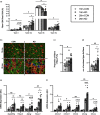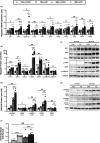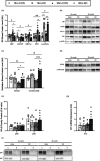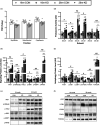The ketogenic diet preserves skeletal muscle with aging in mice
- PMID: 33675103
- PMCID: PMC8045940
- DOI: 10.1111/acel.13322
The ketogenic diet preserves skeletal muscle with aging in mice
Abstract
The causes of the decline in skeletal muscle mass and function with age, known as sarcopenia, are poorly understood. Nutrition (calorie restriction) interventions impact many cellular processes and increase lifespan and preserve muscle mass and function with age. As we previously observed an increase in life span and muscle function in aging mice on a ketogenic diet (KD), we aimed to investigate the effect of a KD on the maintenance of skeletal muscle mass with age and the potential molecular mechanisms of this action. Twelve-month-old mice were assigned to an isocaloric control or KD until 16 or 26 months of age, at which time skeletal muscle was collected for evaluating mass, morphology, and biochemical properties. Skeletal muscle mass was significantly greater at 26 months in the gastrocnemius of mice on the KD. This result in KD mice was associated with a shift in fiber type from type IIb to IIa fibers and a range of molecular parameters including increased markers of NMJ remodeling, mitochondrial biogenesis, oxidative metabolism, and antioxidant capacity, while decreasing endoplasmic reticulum (ER) stress, protein synthesis, and proteasome activity. Overall, this study shows the effectiveness of a long-term KD in mitigating sarcopenia. The diet preferentially preserved oxidative muscle fibers and improved mitochondrial and antioxidant capacity. These adaptations may result in a healthier cellular environment, decreasing oxidative and ER stress resulting in less protein turnover. These shifts allow mice to better maintain muscle mass and function with age.
Keywords: aging; ketogenic diet; mice; sarcopenia; skeletal muscle.
© 2021 The Authors. Aging Cell published by the Anatomical Society and John Wiley & Sons Ltd.
Conflict of interest statement
Authors declare no competing interests.
Figures






References
-
- Baehr, L. M. , West, D. W. , Marcotte, G. , Marshall, A. G. , De Sousa, L. G. , Baar, K. , & Bodine, S. C. (2016). Age‐related deficits in skeletal muscle recovery following disuse are associated with neuromuscular junction instability and ER stress, not impaired protein synthesis. Aging (Albany NY), 8(1), 127–146. 10.18632/aging.100879 - DOI - PMC - PubMed
-
- Bennett, S. L. H. , Smith, A. H. , Ramirez, J. L. , & Thomson, D. M. (2019). Effects of ketogenic diet on p70S6k phosphorylation in young adult and old soleus muscle. The FASEB Journal, 33(1_supplement), lb558‐lb558. 10.1096/fasebj.2019.33.1_supplement.lb558 - DOI
Publication types
MeSH terms
Substances
Grants and funding
LinkOut - more resources
Full Text Sources
Other Literature Sources
Medical
Research Materials

